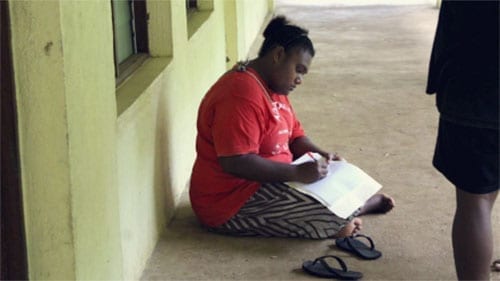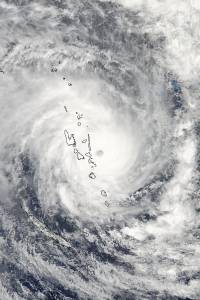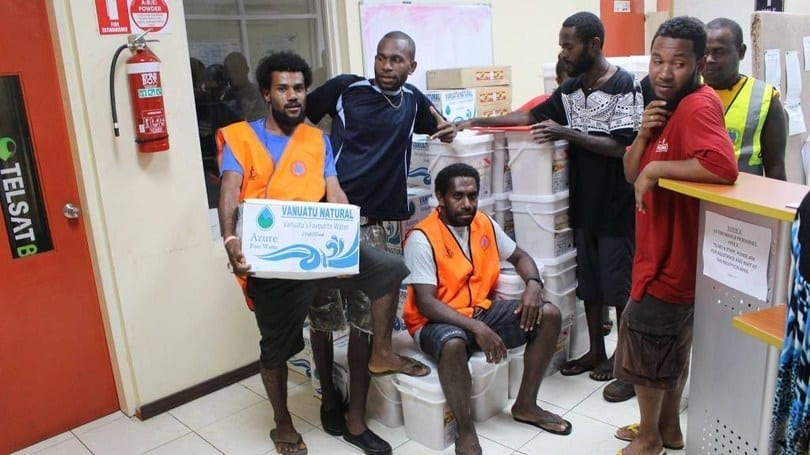350
Vanuatu +
Cyclone Pam
An on-the-ground report from the 350.org Vanuatu Team
Tropical Cyclone Pam is the worst natural disaster in the history of Vanuatu, and the strongest storm ever in the South Pacific.
350 Vanuatu is an indigenous, youth-led organisation who have been leading the climate movement in Vanuatu. As Tropical Cyclone Pam approached, they began mobilising their volunteer base to help communities get prepared and in the aftermath 350 Vanuatu has been helping lead the relief and recovery efforts. They’ve done this with minimal money, but massive amounts of passion, care and amazing grassroots leadership.
They sent us a report of their response — and we feel there is much to learn and be inspired by in how they responded, so we’ve put together this timeline.
This is their story.
Friday, 13 March
23:40h (11:40pm):
In the Port Vila, the capital, our volunteers meet to join the Vanuatu National Disaster Management Office (NDMO) to help the evacuation team get people from rural area to the evacuation centers, as well as help with logistics and operations.
0–1:00h (Midnight–1am):
The NDMO issues the red alert for Shefa, Penama, Sanma, Malampa, and Port Vila. Most of our team is in the 23 evacuation centers throughout Port Vila, counting people and making sure they are safe.
3:00h:
The NDMO recalls all the volunteers for safety purposes. We all come back to the office, with some of our team members going back to their homes or the evacuation centers. Three of us stay overnight in the NDMO office tracking the tropical cyclone and issuing warnings and sending updates on social media.

Merial Masing at 0200HR registering evacuates at Fresh Wota School.
We even have committed females working to make sure people are safe and counted. Merial Masing left home to join our team even when her families were worried about her.
“The lives of these people is important to us, but we do consider the risk to our own life and make sure we’re in a safe place.”
Nauni Natita on staying safe while helping others during the cyclone.

4:00h:
Pam is now about 115km south-southeast of Efate, where Port Vila is situated. We experience destructive wind and heavy rains but we have to clear main streets to allow transport to have access to the hospital.
Communications are down, so roadways are the only way to reach people around Port Vila and make sure everyone is okay.
Our team is mostly NDMO, as well as five 350 volunteers, some members of the Meteorology department, and the Director General of the Ministry of Climate Change. We start clearing the road to the hospital with the help of the Vanuatu Mobile Force (VMF).
“We tried to sleep but the whirling sounds of Pam can’t allow us to rest. We have to be awake and stay alert. At the tipping point of Pam when it reaches Port Vila, island water started flowing into the operations center. The back door broke, so we have to fix it by putting timber across the door… outside all objects were flying like iron sheets, cement walls from the office roof and tree branches. We tried to stay inside and safe from the strong winds and heavy rainfall until early morning the next day.”
—Emil Samuel, Nauni Natita, and Isso Nihmei
Saturday, 14 March, morning:
The red alert for Port Vila has been cleared, but communications are still down. Most of the people found a safe place to spend the night, although very sadly 4 people were killed in the city.
Lots of people show up to help clean and show concern. Volunteers return to reach people and distribute rations. Our allies start mobilizing youths to help clean up — our team of 40 youths split up into five groups to help clearing streets. With debris everywhere we try to put rubbish in heaps.
20:00h (8:00PM)
We get the last warning and Pam officially is out of Vanuatu area. The communication from Port Vila to the other islands is still not possible so we are still in the dark about how people are and what damage the cyclone has caused. We are all hoping to get in touch with our families and friends very soon and find out how we can help them.
In Port Vila a lot of houses were damaged, roofs taken away, some peoples’ homes are completely gone. People taking family members in and supporting each other in cleaning up and getting things out of the under the destroyed house parts. The water is running again but still there is no electricity and it could take another few days due to severe damages.
Photos
“We offer not just support in cleaning up the town area but also to show our commitments to the concern of climate change which will bring more severe tropical cyclones in the future. We will be expecting more category 5 cyclones so people have to prepare in advance.”
—Emil Samuel
Aftermath
The government has to make sure people who have been evacuated have enough food and water for a couple days before they move back to their homes.
Our team is playing a major part in distributing food and water supplies to each evacuation center, and more importantly making sure the food is shared equally among everyone.

With a lot of impressions from this severe and destructive cyclone in the history of Vanuatu, people have learned from this experience and can prepare in advance for future tropical cyclone to safe more life.
Donate to the Relief Effort
Below are organisations who you can donate to in your local area who are supporting the relief and recovery work in the Pacific.
In the USA
Donate to UNICEF USA Cyclone Pam fund
In Australia
Donate to Oxfam Australia’s Cyclone Pam Emergency Appeal
In New Zealand
Donate to Oxfam New Zealand’s Cyclone Pam Emergency Appeal